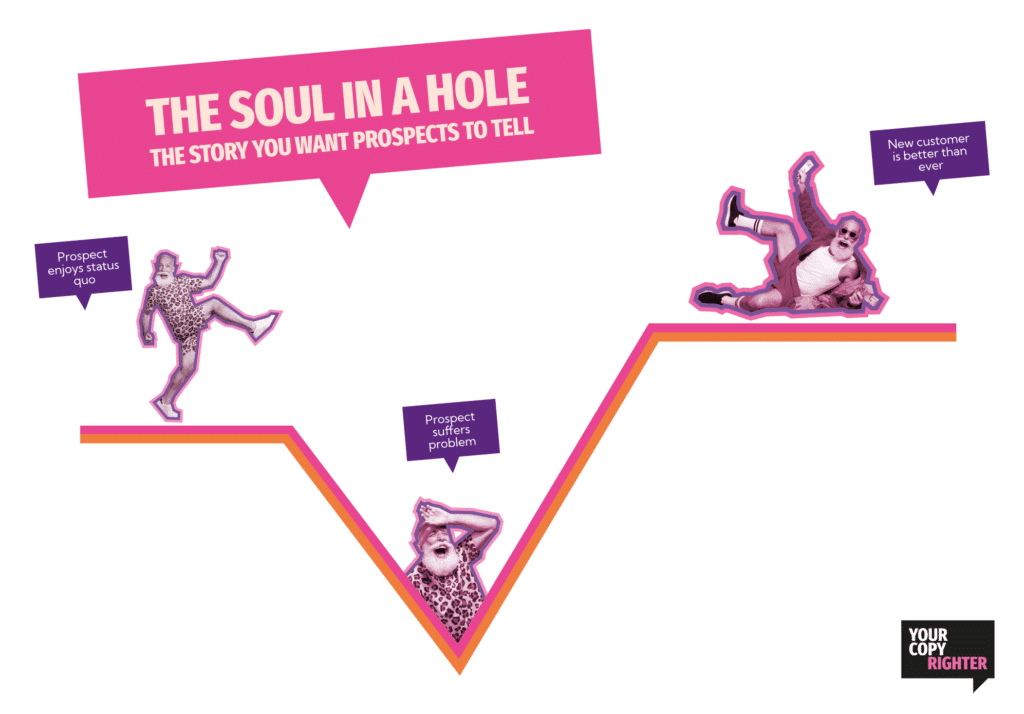
Formulas are great. They promise repeatable success as long as you follow the simple steps. And you want to be certain the effort you’re putting into your copy will deliver results.
But if you’ve looked into copywriting formulas and been addled by AIDA, perplexed by PAS, and even slapped by SLAP, don’t worry about it. Because you only need one formula to deliver return on your investment and deliver results that make you look good:
The Soul in a Hole story.
We’re constantly telling stories about the things we buy. Marketing is, at its core, all about influencing those stories. Because if you’re not influencing those stories, you may not like the role you’re cast in. Bumbling sidekick. Villain. You may not end up in it all.
Influencing the story makes sure your prospect chooses you, your customers remain happy with you, and your word of mouth marketing stays strong and persuasive.
Because an influenced story sounds like “we couldn’t get our new product off the ground until we freed up budget with CountPenny.”
While an uninfluenced story sounds like “We switched our accounting software to something cheaper.”
See the difference? In the influenced story, you’re a named character that helped them do something great. In the uninfluenced story, you’re an unremarkable, unnamed extra.
This doesn’t just make a difference to how a customer speaks about you (and hopefully influences others to buy from you.) It also changes how a prospect thinks about you when trying to decide between you and a competitor.
Because a prospect who’s thinking, “we’ll be able to get that new project off the ground with CountPenny,” is already making you a partner in their success. And you’re coming off a lot better than “that one that’s cheap.”
But how do you get that named, starring role in your prospects’ stories? Tell them Soul in a Hole stories.
The Soul in a Hole model is based on one first described by American writer Kurt Vonnegut. Vonnegut put together a framework of eight different story shapes, including Boy Meets Girl, Cinderella, and Which Way Is Up.
And one of those story shapes he called Man in Hole. Which I, in my arrogance, have redubbed Soul in a Hole for two reasons: it’s less sexist, and it rhymes.
A Soul in a Hole story itself is pretty straightforward:
Hence the hole metaphor. Because falling into a hole definitely makes things worse. And getting out of a hole definitely makes you feel better. The character falls into a hole (things get worse), climbs out (things get better)that puts them in a metaphorical hole, out of which they proceed to climb. In fact, they often end up in a better place than they were at the beginning of the story.
This is exactly how you want customers and suppliers to feel about working with your brand.
It’s how you want your prospects to think they’ll feel about working with you.
And it’s how you want your boss to feel about hiring you.
That things were bad until you came along. And then they were better than ever.

“We updated our computers and all our printers stopped working (the hole). Then I found ACME Printers Ltd, who got them all working again; they even finally sorted that weird toner error we kept getting (better than ever!)”
“We’d won new business but didn’t have enough staff to service the existing customers. Some even grumbled about worse service (the hole.) So I hired Alison. Now we have enough staff and our clients are raving about us; they’re not going anywhere (better than ever!)”
“We’d learned about the environmental impact of email, we tried to find a green, sustainable email marketing platform but couldn’t (the hole.) So we built it ourselves! Now our customers can send their emails knowing it’s all running on green electricity with negative carbon footprint (better than ever!)”
People like to jump over the hole. And that’s a mistake.
This problem is particularly obvious when dealing with existing customers, bosses, suppliers, and so on. The Soul in a Hole story makes sense when winning that audience the first time around. But, once won, people think they should avoid problems at all costs. To tell stories where things just get better and better all the time.
And that’s a mistake. Because things don’t get better without problems to solve first.
Think about your last few appraisals with your boss. Did you walk in and say, “Things were just better this quarter?” Or did you say, “Things were better because I fixed problems”?
Your boss, your customers, your stakeholders all want you to make problems go away. So when you tell them how great you are, keep telling Soul in a Hole stories.
Archiving processes were time-consuming, so you worked to streamline them and now everyone’s saving time.
You noticed the lights weren’t energy efficient so you found some better replacements that cost less money to run.
You noticed the office feng shui was off so you rearranged your desk pens and now everyone’s energy is more harmonious.
The trick is to keep telling Soul in a Hole stories, stringing them together so that each one ends in an even better place than before. The overall trend is upwards, but you’re able to demonstrate your value each time.

The prospect needs to understand the hole they’re in. Otherwise, they can’t appreciate how much you helped them out of it.
So make sure you’re defining the real problem for them. It’s not that the accounting software was too expensive; it’s that you wanted room in the budget to launch your next project.
It’s not that your phone was slow; it’s that you were missing moments.
It’s not that data capture was taking too long; it’s that you had to pay overtime to hit SLAs.
Is solving the problem your USP? Excellent. Make that clear. No-one else charges less for accounting software. No-one else’s camera takes photos as fast as yours. No-one else’s data capture is faster.
But, odds are, that won’t be the case. So, if you can’t claim that no-one else does what you do, make it clear that no-one else understands the problem like you do. Because then they know your focus is where they want it to be.
Selling on price is a race to the bottom. What you do is remove the bloat from software and cost. Trimming the fat to keep your customers’ invoices lean.
Lots of people can claim “faster,” and it can mean many things. “Takes photos in one tap” is what your prospect is looking for.
How many people offer “automated data capture?” But it’s your focus on “minimal human involvement” that will keep your prospect’s overtime bill down.
Sometimes your audience won’t feel like they’re in a hole. Or sometimes you won’t be sure how to tell them how you got them out. That’s okay. Some stories are easier to tell than others. If you’re struggling, remember to boil it all down to the simplest Soul in a Hole you can:
And if you’re still struggling with it, don’t fret: get in touch and I’ll help you get your Soul in a Hole stories righter!
